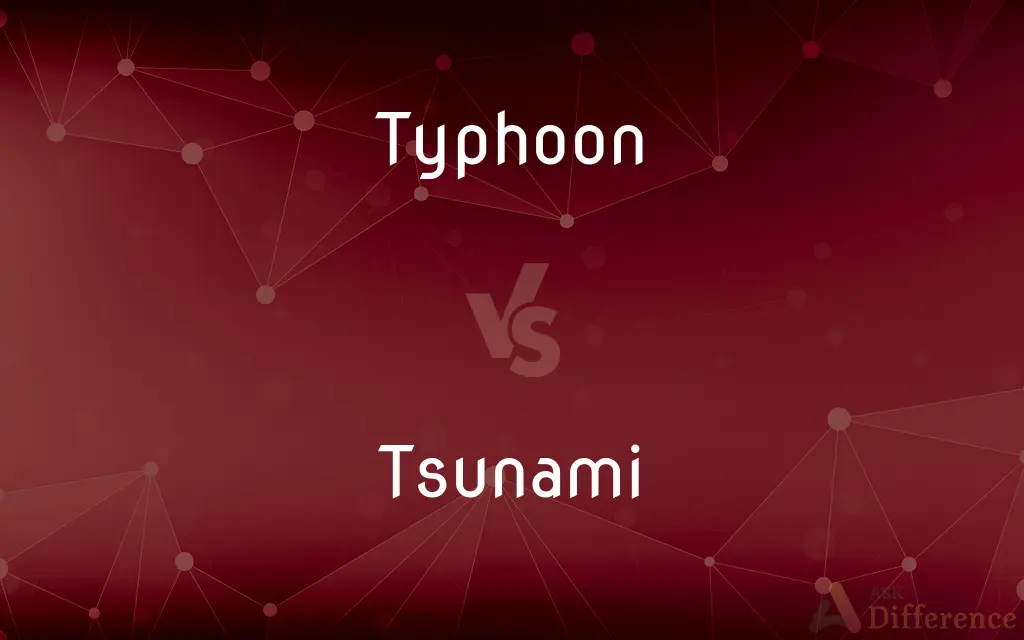Typhoon vs. Tsunami — What's the Difference?
Edited by Tayyaba Rehman — By Fiza Rafique — Updated on September 21, 2023
A typhoon is a tropical cyclone that occurs in the Northwest Pacific Ocean, characterized by strong winds and heavy rains. A tsunami is a series of ocean waves with very long wavelengths, typically caused by underwater earthquakes, volcanic eruptions.

Difference Between Typhoon and Tsunami
Table of Contents
ADVERTISEMENT
Key Differences
A typhoon is a type of tropical cyclone that forms over warm ocean waters, specifically in the Northwest Pacific region. Typhoons are characterized by strong winds, heavy rain, and low atmospheric pressure. These storms are a meteorological phenomenon and can last for days or even weeks.
A tsunami, on the other hand, is a series of ocean waves generated by abrupt movements of the Earth's crust, such as earthquakes, volcanic eruptions, or landslides. Tsunamis are not weather-related but rather are geological phenomena. These waves can travel vast distances across ocean basins and reach heights of up to 100 feet.
While typhoons are essentially atmospheric events that involve the Earth's atmosphere and weather systems, tsunamis are seismic events related to the Earth's geological activity. Typhoons are driven by heat energy from warm ocean water, whereas tsunamis are caused by the displacement of large volumes of water due to tectonic activity.
Typhoons usually provide some warning time as meteorologists can track their formation and progression using various technological tools like satellites and weather radar. Tsunamis, however, often occur with little to no warning, making them especially dangerous and devastating.
Comparison Chart
Nature
Meteorological
Geological
ADVERTISEMENT
Cause
Warm ocean water, low-pressure systems
Underwater earthquakes, volcanic eruptions, landslides
Warning Time
Generally available
Often little to no warning
Duration
Can last days or weeks
Usually minutes to hours
Area of Occurrence
Northwest Pacific Ocean
Any ocean basin
Compare with Definitions
Typhoon
A tropical cyclone in the Northwest Pacific Ocean.
The typhoon hit Japan with strong winds and heavy rain.
Tsunami
A seismic sea wave.
Tsunamis are not caused by wind or tides but by seismic activity.
Typhoon
A severe storm characterized by strong winds.
The typhoon uprooted trees and damaged houses.
Tsunami
A large ocean wave caused by seismic activity.
The earthquake triggered a devastating tsunami.
Typhoon
A weather phenomenon fueled by warm ocean waters.
The warm sea temperature contributed to the typhoon's strength.
Tsunami
A series of ocean waves with long wavelengths.
The tsunami traveled across the entire ocean basin.
Typhoon
A meteorological event with low atmospheric pressure.
The typhoon's low pressure caused a storm surge.
Tsunami
A fast-moving, high-energy wave.
The tsunami reached speeds up to 500 miles per hour.
Typhoon
A rotating storm system in the Pacific.
The typhoon was visible on the satellite as a well-defined spiral.
Tsunami
A tsunami ( (t)soo-NAH-mee, (t)suu-; from Japanese: 津波, lit. 'harbour wave', pronounced [tsɯnami]) is a series of waves in a water body caused by the displacement of a large volume of water, generally in an ocean or a large lake. Earthquakes, volcanic eruptions and other underwater explosions (including detonations, landslides, glacier calvings, meteorite impacts and other disturbances) above or below water all have the potential to generate a tsunami.
Typhoon
A typhoon is a mature tropical cyclone that develops between 180° and 100°E in the Northern Hemisphere. This region is referred to as the Northwestern Pacific Basin, and is the most active tropical cyclone basin on Earth, accounting for almost one-third of the world's annual tropical cyclones.
Tsunami
A long, high sea wave caused by an earthquake or other disturbance
The loss of human lives from this latest tsunami is staggering
Typhoon
A tropical cyclone occurring in the western Pacific or Indian Oceans.
Tsunami
A very large ocean wave caused by an underwater earthquake or volcanic eruption.
Typhoon
A weather phenomenon in the northwestern Pacific that is precisely equivalent to a hurricane, which results in wind speeds of 64 knots (118 km/h) or above. Equivalent to a cyclone in the Indian Ocean and Indonesia/Australia.
Tsunami
A very large and destructive wave, generally caused by a tremendous disturbance in the ocean, such as an undersea earthquake or volcanic eruption. Tsunami are usually a series of waves, or wave train.
Typhoon
(intransitive) To swirl like a hurricane.
Tsunami
(figurative) A large and generally unstoppable surge.
Typhoon
A violent whirlwind; specifically, a violent whirlwind occurring in the Chinese seas.
Tsunami
A huge destructive wave (especially one caused by an earthquake)
Typhoon
A tropical cyclone occurring in the western Pacific or Indian oceans
Tsunami
A natural disaster usually linked to earthquakes.
The underwater earthquake was the catalyst for the tsunami.
Common Curiosities
What is a typhoon?
A typhoon is a strong tropical cyclone in the Northwest Pacific Ocean.
What causes typhoons?
Typhoons are caused by warm ocean waters and low atmospheric pressure.
What causes tsunamis?
Tsunamis are caused by underwater earthquakes, volcanic eruptions, or landslides.
How are typhoons and tsunamis different?
Typhoons are atmospheric; tsunamis are seismic.
How long does a tsunami last?
Tsunamis usually last for minutes to hours.
What is a tsunami?
A tsunami is a large ocean wave usually caused by seismic activity.
Are typhoons predictable?
Yes, typhoons can be tracked and predicted to some extent.
Are typhoons and tsunamis related to climate change?
Typhoon intensity may be influenced by climate change; tsunamis are not.
Can a typhoon trigger a tsunami?
No, typhoons and tsunamis have different causes.
How long does a typhoon last?
Typhoons can last for days or even weeks.
Can typhoons and tsunamis be prevented?
No, but their impacts can be mitigated through preparedness.
What regions are most affected by tsunamis?
Tsunamis can affect any coastal region near an ocean basin.
Are tsunamis predictable?
Tsunamis often occur with little to no warning.
What regions are most affected by typhoons?
The Northwest Pacific region is most affected by typhoons.
What is the deadliest aspect of a typhoon and a tsunami?
For typhoons, it's often flooding; for tsunamis, it's the impact of the waves.
Share Your Discovery

Previous Comparison
Illiterate vs. Aliteracy
Next Comparison
Statue vs. MannequinAuthor Spotlight
Written by
Fiza RafiqueFiza Rafique is a skilled content writer at AskDifference.com, where she meticulously refines and enhances written pieces. Drawing from her vast editorial expertise, Fiza ensures clarity, accuracy, and precision in every article. Passionate about language, she continually seeks to elevate the quality of content for readers worldwide.
Edited by
Tayyaba RehmanTayyaba Rehman is a distinguished writer, currently serving as a primary contributor to askdifference.com. As a researcher in semantics and etymology, Tayyaba's passion for the complexity of languages and their distinctions has found a perfect home on the platform. Tayyaba delves into the intricacies of language, distinguishing between commonly confused words and phrases, thereby providing clarity for readers worldwide.
















































